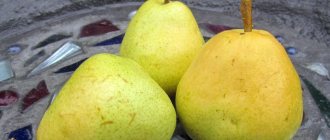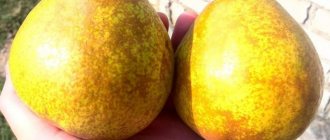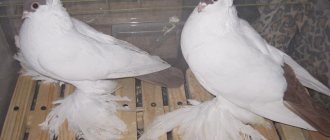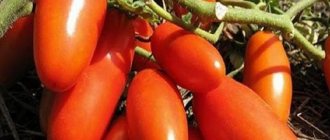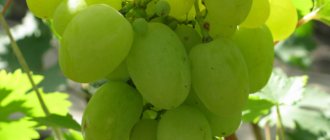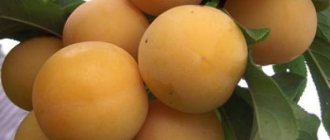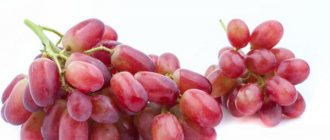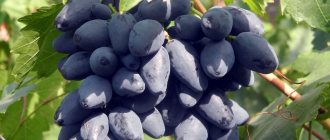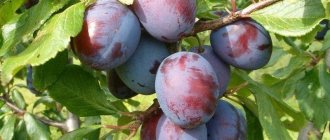Orlovskie pears.
Description of the variety
Orlovskaya pear belongs to the group of summer ripening varieties and is best suited for cultivation in the Central Black Earth region.
Characteristics of wood
Trees of this variety are vigorous and can reach a height of 8 meters. The crown has a pyramidal or wide pyramidal shape. The crown density is average or above average. The trunk and main branches are covered with smooth gray bark. The leaves are large, dark green, round or oblong in shape. The leaf blade is smooth, with a characteristic shine. The flowers are white and large.
Description of fruits
Orlovskaya summer.
Fruits are medium to above average size. The weight of one pear ranges from 150 to 270 grams. The shape of the fruit is standard, pear-shaped. Ripe fruits are yellow-green. There are subcutaneous dots and a slight blush on the surface of the pear.
The fruits are tender, sweet, semi-oily, with a faint aroma.
Harvest ripening occurs at the end of July - beginning of August. The duration of storage of the harvested crop is from 1 to 3 weeks.
History of selection and region of breeding
The year of birth of the Oryol Summer variety was 1977, and the place of birth was the oldest domestic horticultural scientific institution, the All-Russian Research Institute of Fruit Crop Breeding (VNIISPK), which is located in the Oryol region.
A whole group of scientists led by one of the pioneers in the field of breeding fruit and berry crops, Doctor of Agricultural Sciences Evgeniy Sedov, worked on the creation of a promising new product.
To obtain a new variety, suitable in several respects for the very difficult climatic conditions of central Russia, researchers crossed two pear species - “Bergamot Novik” and “Klapp’s Favorite” .
Peanut oil - composition, medicinal and beneficial properties, benefits and harms. Application. Calorie content. Contraindications. How to choose and store peanut butter. || Buy in the online store || Peanut butter for a healthy diet || Vegetable oil for a healthy diet
As a result, a pear was created whose pedigree contains only European pear varieties.
Soon, “Oryol Summer” was included in the state varietal register for the Central Black Earth region .
At first, it became widespread mainly in relatively small country gardens and personal plots.
However, recently its popularity has been rapidly growing among gardeners and farmers who have seen the benefits of growing this variety on an industrial scale.
In these regions, Hera, Pamyati Yakovlev, Bere Russkaya, Lada and Dessertnaya Rossoshanskaya feel excellent.
Forms and subspecies
There are two different subspecies of the Oryol pear found in Russia:
- Orlovskaya Beauty.
Oryol beauty.
The crown of the tree is dense and pyramidal in shape. The leaves are oblong, oval. The weight of one fruit is about 150 grams. The color of pears is distinguished by a large number of small subcutaneous dots and a dark red blush. The fruits ripen in early August and are stored for 2-3 weeks.
- Orlovskaya Summer. The crown of the pear is wide, medium-thick, pyramidal in shape. The foliage has a round shape. The weight of one pear is 210-270 grams. There are few subcutaneous points on the surface of the fetus. A slight orange blush may appear on the pear. The harvest is harvested at the end of July. The shelf life of fruits does not exceed 7-10 days.
Excellent taste of large fruits - Oryol summer pear
A considerable part of all known pear crops are plants with summer ripening periods.
One of these is the Oryol summer pear - a description of the variety, photos of the fruits and reviews later in the article.
Usually this pear, with due attention to it, is distinguished by regular impressive harvests .
At the same time, the variety is famous for its high commercial quality and excellent taste.
And all this has taken root well in the conditions of central Russia, which are not the most “hospitable” for heat-loving plants.
What type does it belong to?
The Oryol summer pear is a classic triploid variety with early summer ripening.
Triploidy indicates that this crop is genetically a plant organism with a triple chromosome set.
This quality is very valuable for growing fruit trees, since triploid crops are usually characterized by increased yield, increased fruit size and good resistance to fungal diseases.
According to many scientists, triploidity for industrial breeding of pear species is the best option.
“Oryol Summer” ripens - depending on the place where it is grown - in the second or third ten days of July (in its homeland - the Oryol region - this species usually gives removable ripeness at the end of July).
Being a typical summer crop, this pear has a rather short shelf life. The period from the moment the fruit is removed from the branches until it is consumed fresh, during which the pear does not change its technical and taste properties and is not spoiled, is no more than 7-10 days.
The low degree of keeping quality of Oryol Summer fruits is assessed by many experts as its significant drawback. At the same time, among the early summer pear varieties common today in central Russia , the Orlovskaya summer pear variety is considered the largest-fruited , which, of course, makes it very popular among gardeners.
History of selection and region of breeding
The year of birth of the Oryol Summer variety was 1977, and the place of birth was the oldest domestic horticultural scientific institution, the All-Russian Research Institute of Fruit Crop Breeding (VNIISPK), which is located in the Oryol region.
A whole group of scientists led by one of the pioneers in the field of breeding fruit and berry crops, Doctor of Agricultural Sciences Evgeniy Sedov, worked on the creation of a promising new product.
To obtain a new variety, suitable in several respects for the very difficult climatic conditions of central Russia, researchers crossed two pear species - “Bergamot Novik” and “Klapp’s Favorite” .
As a result, a pear was created whose pedigree contains only European pear varieties.
Soon, “Oryol Summer” was included in the state varietal register for the Central Black Earth region .
At first, it became widespread mainly in relatively small country gardens and personal plots.
However, recently its popularity has been rapidly growing among gardeners and farmers who have seen the benefits of growing this variety on an industrial scale.
Description of the Orlovskaya summer variety
The Orlovskaya summer pear variety is characterized by the following specific features and structure, followed by a description of the external characteristics and photos:
Tree
As a rule, this plant is significantly taller than average. The bark on its trunk is smooth to the touch and has a gray or gray-greenish color.
Crown, branches. The tall tree has a fairly wide crown in the form of an almost regular pyramid.
The top is formed by moderately curved branches, which are located quite sparsely (average density of the crown).
An acute angle (about 45°) is usually formed between the branches, with their ends pointing upward, and the trunk. The branches are covered with smooth gray bark.
Escape. Thickened shoots of a straight configuration have a rounded cross-section. There is no pubescence on the shoots.
The color of these formations is brown or light brown. Large, smooth, brown buds on the shoots are in a pressed position. Pear fruiting occurs on ringlets - both simple and complex.
Leaves. They are distinguished mainly by their rather large sizes and rounded (oval) silhouette. The tops of the leaves are shortened and pointed.
The standard Orlovskaya Summer leaf has a smooth, green or dark green surface with a distinct gloss, as well as slight nervation (the appearance of veins on the leaf surface).
The upward concavity of the plate is noteworthy. The edges of the leaves are even, with small teeth visible on the edges. The leaves are held on medium-long, thin petioles.
Inflorescences. The flowers bloom from large buds with a characteristic pointed cone. The flowers are usually large, with round white petals that slightly overlap each other.
Fruit
Ripe pears of this variety are traditionally large in size .
Their average weight is about 210 g, but fruits of even greater weight are periodically recorded ( the known maximum weight of the Oryol summer pear is 270 g) .
Of the early summer varieties cultivated on farms in central Russia, this is the largest-fruited pear.
Added to the record weight are other external advantages of the fruit - their “classic” pear-shaped shape and one-dimensionality.
The basic color of a pear at the stage of removable ripeness is green; by the time of consumer ripeness, it acquires a greenish-yellow hue. In this case, a characteristic orange blush often appears on a certain segment of the fetus, formed by numerous merging dots.
In addition to its pleasant color, the matte skin is characterized by noticeable smoothness, dryness and sufficient strength. A few small subcutaneous dots are visible on the skin. The pulp is mostly white, with a faint greenish tint visible only near the skin.
The pulp is characterized by a fairly dense consistency, with fine grains and an oily coating, as well as increased juiciness. Inside the pulp are large, brown seeds. External attractiveness is assessed by experts at 4.6 points (on a 5-point scale).
Characteristics
The advantages of the Orlovskaya Summer variety are not limited to attractive external parameters.
This fruit crop is characterized by good frost resistance and high yield (of course, with strict and timely implementation of all agrotechnical rules for growing this plant).
Perhaps the only significant drawback of this early-fruiting variety is that its fruits must be consumed in a relatively short period after being picked from the tree.
The basic level of winter hardiness was established based on the results of wintering pears in the Oryol region.
Planted in climatic zones other than the Oryol region, Oryol summer trees may behave differently when cold weather sets in.
The tree tolerates significant drops in temperature and windy weather , which are traditional for winters in central Russia.
At the same time, frozen parts of the tree, according to observations, quickly restore their original qualities.
The high yield of the variety is expressed in seasonal fruit harvests at an average level of 180-210 centners of fresh produce per hectare of garden. The taste properties of ripe fruits are also excellent – sweet and very aromatic.
Experts rate their tasting attractiveness as high as their external indicators - 4.6 points on the corresponding five-point scale.
The chemical composition of a properly grown, processed and aged fruit is as follows:
| Compound | Quantity |
| Sahara | 8,3% |
| Titratable acids | 0,16% |
| Solids | 10,2% |
| Ascorbic acid | 5.6 mg/100 g |
| P-active substances | 36.4 mg/100 g |
The fruits of the “Orlovskaya Letnaya” variety are very useful as raw materials for the preparation of various medicines both in folk medicine and in “official” pharmacology.
They perform especially well in the treatment of various bronchitis and acute respiratory infections.
These pears have a universal purpose.
This means that they are widely consumed both fresh and as raw materials for the preparation of various compotes, preserves, jellies, marmalades, honeys and alcoholic tinctures.
Planting and care
Despite the fact that “Oryol Summer” is generally not very demanding on soil quality , it is still better if the soil at the site of its planting is fertile (enriched) and cultivated.
for the seedling , the depth of which should be 1 m and the diameter 70 cm . Pour 2 buckets of water into the hole and leave it for a week and a half to settle.
When planting, the seedling is placed so that its roots can be freely spread in the hole.
The root system is covered with soil extracted when digging the same hole, mixed with fertilizer and river sand.
After the roots are covered with soil mixture, the root collar should protrude 6-7 cm above the ground surface.
Having surrounded the trunk of the planted tree with a 2-3 cm earthen rampart with a radius of 40 cm , a funnel of a trunk circle is formed. It is immediately filled with 2-3 buckets of settled water.
Subsequently, the tree is regularly watered, the soil around the trunk and under the crown is loosened, the soil is periodically fertilized, dried and overgrown branches are trimmed, and protection from pests is provided.
Diseases and pests
"Orlovskaya summer" is very resistant to https://selo.guru/ptitsa/bolezni-p/gribkovye/parsha.html and other diseases such as rust or fire blight.
As for protecting the plant from rodents that can damage the bark in winter, for this the trunk and lower branches should be wrapped with a special metallized mesh or coarse rags.
If the gardener responsibly approaches all stages of planting and caring for the plant, after a while the pear will “thank” its owner with excellent, tasty fruits.
If you find an error, please select a piece of text and press Ctrl+Enter.
Reviews
I have been growing Orlovskaya Letnaya for more than 20 years. The fruits of this variety are the first to ripen in the garden, which is why my grandchildren are very fond of them. Pears do not last long and, given the quantity of the harvest, most of it has to be processed immediately.
Nina Viktorovna
Stary Oskol
The Orlovskaya tree is large and tall. It is very good that he has good immunity, since it would be difficult to spray him often. The variety itself, I think, is one of the best in our area.
Leonid
Michurinsk
Oryol Beauty has been growing in my garden for about 10 years. The variety has practically no flaws and, in principle, suits me in everything. Pears can be stored in the refrigerator for up to a month. In my opinion, this has good shelf life for a summer variety.
Konstantin
Znamenka
Characteristics
The advantages of the Orlovskaya Summer variety are not limited to attractive external parameters.
This fruit crop is characterized by good frost resistance and high yield (of course, with strict and timely implementation of all agrotechnical rules for growing this plant).
Perhaps the only significant drawback of this early-fruiting variety is that its fruits must be consumed in a relatively short period after being picked from the tree.
The basic level of winter hardiness was established based on the results of wintering pears in the Oryol region.
Planted in climatic zones other than the Oryol region, Oryol summer trees may behave differently when cold weather sets in.
The tree tolerates significant drops in temperature and windy weather , which are traditional for winters in central Russia.
At the same time, frozen parts of the tree, according to observations, quickly restore their original qualities.
The high yield of the variety is expressed in seasonal fruit harvests at an average level of 180-210 centners of fresh produce per hectare of garden. The taste properties of ripe fruits are also excellent – sweet and very aromatic.
Experts rate their tasting attractiveness as high as their external indicators - 4.6 points on the corresponding five-point scale.
The chemical composition of a properly grown, processed and aged fruit is as follows:
| Compound | Quantity |
| Sahara | 8,3% |
| Titratable acids | 0,16% |
| Solids | 10,2% |
| Ascorbic acid | 5.6 mg/100 g |
| P-active substances | 36.4 mg/100 g |
The fruits of the “Orlovskaya Letnaya” variety are very useful as raw materials for the preparation of various medicines both in folk medicine and in “official” pharmacology.
They perform especially well in the treatment of various bronchitis and acute respiratory infections.
These pears have a universal purpose.
This means that they are widely consumed both fresh and as raw materials for the preparation of various compotes, preserves, jellies, marmalades, honeys and alcoholic tinctures.
Landing
Orlovskaya pear adapts well to different types of soil, but is most productive on loose, fertile soil. In the articles selected below, you can find detailed instructions on planting a tree.
How to plant a pear tree correctly
At what distance to plant pears?
How to choose pear seedlings
How to replant a pear
Separation depending on the size and taste of the fruit
If we want to pick a pear, then first of all we look at the quality of its fruit, since after all, we grow trees not for the sake of beauty, but for the sake of a rich harvest. Studying the description of pear varieties, you can understand that the fruits are divided by size and taste.
Many people love large pears, but small fruits are sometimes not inferior in quality.
All varieties of pears are divided into three groups:
Large ones. They have fruits ranging from 200 to 500 grams. Many trees regularly bear fruits that reach gigantic sizes without the use of chemicals. These varieties include “Marshal Zhukov”, “Osennyaya krupnaya”, “Vidnaya” and others.
Fruit sizes vary from 50 to 600 grams
Average. They weigh from 80 to 200 g. Most varieties of pears fall into this category. Trees are often overloaded with harvest, since this group is distinguished by its fertility. These include “Melting”, “Ilyinka”, “Annushka” and others.
Small ones. Their fruits weigh only 30 - 80 g. Such pears are often used for making compotes, jams, and desserts. These are “Veselinka”, “Olga”, “Thumbelina” and others.
The taste of pears is influenced by many factors. It depends on the weather, the storage conditions of the fruit, the time when the crop was harvested, and so on. But still, the main factor is the variety you choose. All pears are divided into 3 categories according to taste:
Sweet. These varieties are the most in demand and popular. They are classified as universal, as they are suitable for fresh consumption and are also suitable for preparation.
Columnar-shaped honey pear
The human body better absorbs sweet fruits that do not cause stomach upset. These are the famous varieties “Honey”, “Summer Duchess”, “Children’s” and others.
Sweet and sour. Most varieties of pears have a sweet and sour taste, not sweet, which is appreciated by many gardeners. Therefore, the fruits are obtained with a refreshing, tonic taste. They increase appetite and are good for the liver. There are many such pears, including “Volga Autumn”, “Bere Napoleon”, “Firefly” and others.
Tart, astringent. Their peel contains a lot of tannins, so the fruits are bitter and have a tart taste. These are “Sibiryachka”, “Pervomayskaya”, “Astrakhanskaya rannyaya”.
Pear jam is made from technical and universal varieties
Use of fruits
Pears are divided into varieties and according to the method of using the fruit.
- Dining rooms. They are also called dessert ones. They are eaten fresh. They have excellent taste, many of them do not spoil, and they are distinguished by good transportability. These include “Marble”, “Quiet Don”, “Rassvet”.
- Technical. They are grown for further processing, for preservation or for preparing various dishes. They do not have such an attractive appearance, but they have good taste and aroma. These are “Granddaughter”, “Allegro”, “Oryol Summer”.
- Universal. Suitable for both processing and food: “Zoya”, “Academic”, “Podkumok”.
Growing a promising pear "Thumbelina"
Care
Trees of this variety successfully grow and bear fruit with minimal care. Useful recommendations for growing Orlovskaya pear varieties and subspecies can be found by clicking on the links below.
How to care for a pear Pruning a pear Pruning a columnar pear Treating a pear from diseases and pests Feeding a pear How to water a pear
What species is this variety?
The Thumbelina pear got its name from its small tree and its miniature fruits. This variety is a late-ripening autumn variety. Does not grow in industrial gardens.
The Thumbelina pear variety is only suitable for amateur use due to its low yield and small fruits of no more than 60 grams. At home, pears of this variety are used to make: jam, wine, compotes, candied fruits, marmalade, jam, honey.
Used in folk medicine. The fruits of the variety purify blood composition and rheology. Helps with menopausal disorders. Regular consumption of pear fruits helps rejuvenate the body.
Cellulite and folds on the skin are smoothed out, and excess salt deposits are removed. The fruits are useful for intoxication, alcohol, chemical, food and drug poisoning.
They successfully eliminate allergic dermatitis.
Diseases and pests
The variety has good resistance to various diseases and to maintain strong immunity, it is enough to carry out preventive measures periodically. By clicking on the links below, you can find useful information on the issue of protecting the Orlovskaya pear plant.
Dangerous Pear Pests
Pears often suffer from pests, they affect the leaves, bark and fruits.
In this article, we have selected 11 of the most harmful insects that harm pear trees, and also ways to destroy them.
Diseases of pear trees
To get what they cherish, gardeners have to work hard, and the reason for this is pear diseases.
Read about 19 common pear diseases and how to combat them.
Characteristics of the Orlovskaya Summer pear variety
The Orlovskaya Summer pear has been pleasing gardeners for more than 40 years. The variety was bred at a research institute in the Oryol region back in 1977. Initially, it was intended for planting in the central zone of our country, but now it is grown beyond its borders.
Characteristics of the Orlovskaya Summer pear variety
Characteristics of the variety
The Orlovskaya Summer pear variety is distinguished by its annual abundant harvests. It belongs to the early species. The fruits from the trees are collected at the end of July. They have an excellent taste and attractive appearance, but they do not last long, which is typical for typical summer varieties.
Plants of this variety are triplodic. They are considered to have better yields. The variety is characterized by large fruits that are not affected by fungal diseases. This contributes to the fact that Orlovskaya Letnaya is grown not only in summer cottages, but also for industrial purposes.
Orlovskaya Summer is the leader in fruit size among early ripening species. Due to the excellent taste of pears, they are consumed raw, and also used to prepare fruit salads, jams and preserves, added to baked goods, desserts, marmalade, and compotes.
Description of the tree
Plants are tall and spreading. The crown has a fairly symmetrical wide-pyramidal shape. The bark of the trunk is gray with a greenish tint, on the shoots it is more brown.
The branches are thick, their number decreases from bottom to top: at the bottom there is much more than at the top. The dark green leaves have an oval shape and a beautiful glossy surface.
Flowering is abundant and beautiful. The inflorescences are white and quite large.
Description of fruits
Pears weigh from 210 to 250-270 grams. All fruits are approximately the same size, have a classic shape, but slightly sloping.
At the stage of technical ripeness, the surface has a green color, which becomes slightly yellowish as it ripens completely. The fruit is characterized by a light orange blush, which is formed by many dots merging into one.
All fruits are approximately the same size, have a classic shape,
The skin is very durable, smooth, without shine. Subcutaneous points are not very noticeable. The pulp is very dense, juicy and slightly oily. It has a white color, which becomes greenish closer to the skin.
Advantages
Among the advantages, the following should be highlighted:
- high plant productivity;
- excellent taste and versatility of fruit use;
- cold resistance;
- low maintenance;
- resistance to the most common diseases;
- early ripeness;
- large-fruited.
Landing
The main stage of growing is choosing a good seedling and a suitable place for planting. The tree must be without damage, with a good root system and shoots. For planting, choose a well-lit place without strong winds and drafts.
The planting hole is prepared in advance and 2 buckets of water are poured into it one and a half to two weeks before planting. The hole should be at least 70 cm in diameter and about 1 m deep.
Before planting, pre-prepared humus or wood ash is poured onto the bottom, after which the seedling is lowered into the hole. The root system should be freely located in it. The top is covered with a mixture of soil and fertilizers.
It is important to ensure that the root collar remains above the soil surface. A funnel is formed around the tree, into which several buckets of water are immediately poured.
The variety is a cold-resistant species, so it does not require additional shelter for the winter.
It is necessary to protect plants from rodents that like to eat tree bark. To avoid this, the barrel is wrapped with a special metal mesh.
Trimming
Trees need pruning, which should be done in spring and autumn, starting from the second year of life. In the spring, excess shoots are pruned, and in the fall, sanitary pruning is performed, during which all dry and damaged branches are removed.
Pruning should be done in spring and autumn
Watering
An integral stage of care is regular loosening of the soil and regular watering. Young trees need more frequent watering than mature trees. Mature trees should be watered weekly only during the period of fruit ripening. The rest of the time, focus on the condition of the soil.
Possible diseases
A distinctive feature of the Oryol Summer pear is its resistance to such common diseases as scab, fire blight and rust.
The description says that among the insects that often harm trees are green aphids, codling moths and copperheads. You can fight them with Bordeaux mixture.

